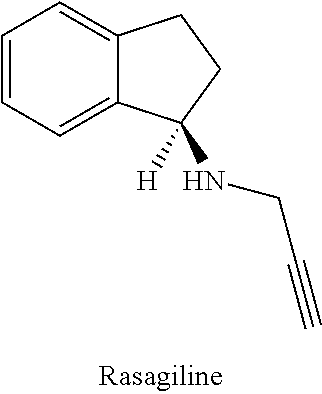Combination of rasagiline and pridopidine for treating neurodegenerative disorders, in particular huntington's disease
a neurodegenerative disorder and pridopidine technology, applied in the field of huntington's disease, can solve the problems of increasing the difficulty of walking and swallowing, increasing the severity of dementia, and currently no cure for hd, and achieve the effect of treating the human patien
- Summary
- Abstract
- Description
- Claims
- Application Information
AI Technical Summary
Benefits of technology
Problems solved by technology
Method used
Image
Examples
example 1
Animal Models of Huntington's Disease
[0116]Most animal models of HD fall into two broad categories, genetic and non-genetic. Historically, nongenetic models have dominated the field of HD research, and typically induce cell death either by excitotoxic mechanisms of by disruption of mitochondrial machinery. Quinolinic acid and kainic acid have been the two most commonly used excitotoxic agents in both rodent and primate models of HD (Ramaswamy, 2007). Emerging molecular technology has enabled the development of genetic murine and, more recently, rat models that attempt to capture the hereditary nature of HD. There are two main categories of genetic mouse models, transgenic and knock-in. Transgenic mice results from the random insertion of a portion of the human htt gene, containing the polyglutamine repeat, in the mouse genome, the expression of which can be driven by different promoters. Alternatively, “knocking in” a portion of the human htt gene in the mouse htt gene locus on chro...
example 1.1
Toxin models of HD
[0117]A quinolinic acid (QA) rat model is periodically administered an amount of rasagiline and an amount pridopidine. The periodic administration of rasagiline and pridopidine is more effective (provides at least an additive effect or more than an additive effect) in preventing or attenuating weight loss, slowing, inhibiting, or reversing progression of motor, cognitive or behavioral symptoms, improving performance on the rotarod test, gait test, clasping test, and open-field test, slowing, inhibiting, or reversing progression of neurodegeneration in the brain, and prolonging survival, in the rat than when pridopidine alone or rasagiline alone is administered at the same repetitive dose.
[0118]A 3-Nitro-propionic acid (3-NP) rat model is periodically administered an amount of rasagiline and an amount pridopidine. The periodic administration of rasagiline and pridopidine is more effective (provides at least an additive effect or more than an additive effect) in prev...
example 1.2
Transgenic Models of HD
[0119]A R6 / 2 mouse model is periodically administered an amount of rasagiline and an amount pridopidine. The periodic administration of rasagiline and pridopidine is more effective (provides at least an additive effect or more than an additive effect) in preventing or attenuating weight loss, slowing, inhibiting, or reversing progression of motor, cognitive or behavioral symptoms, improving performance on the rotarod test, gait test, clasping test, and open-field test, slowing, inhibiting, or reversing progression of neurodegeneration in the brain, and prolonging survival, in the mouse than when pridopidine alone or rasagiline alone is administered at the same repetitive dose.
PUM
| Property | Measurement | Unit |
|---|---|---|
| weight | aaaaa | aaaaa |
| weight | aaaaa | aaaaa |
| neurodegenerative disorder | aaaaa | aaaaa |
Abstract
Description
Claims
Application Information
 Login to View More
Login to View More - R&D
- Intellectual Property
- Life Sciences
- Materials
- Tech Scout
- Unparalleled Data Quality
- Higher Quality Content
- 60% Fewer Hallucinations
Browse by: Latest US Patents, China's latest patents, Technical Efficacy Thesaurus, Application Domain, Technology Topic, Popular Technical Reports.
© 2025 PatSnap. All rights reserved.Legal|Privacy policy|Modern Slavery Act Transparency Statement|Sitemap|About US| Contact US: help@patsnap.com

